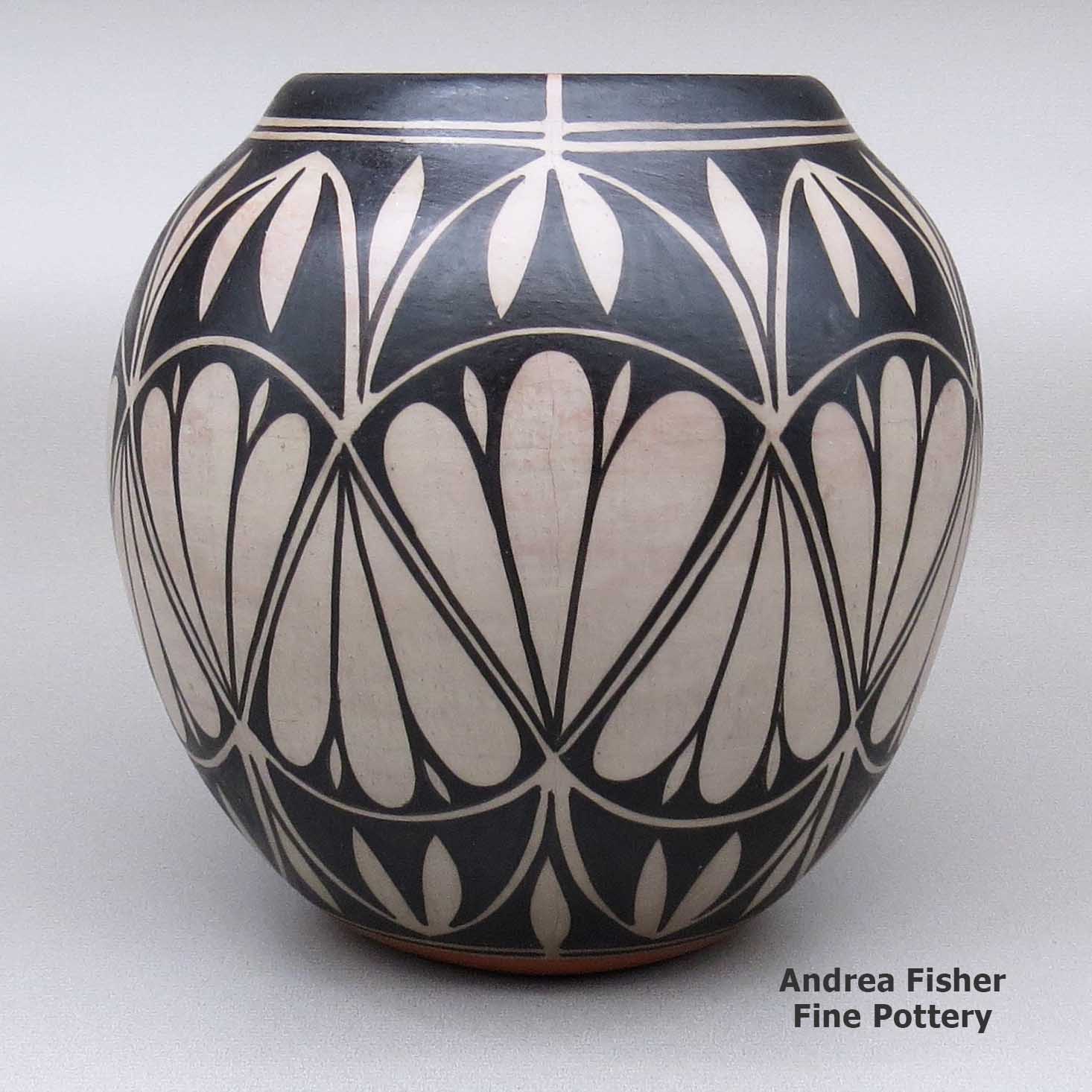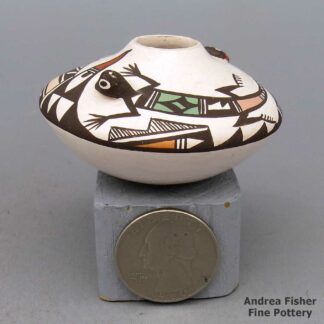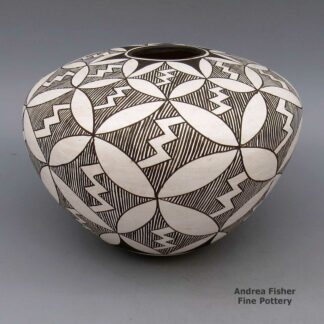| Dimensions | 5 × 5 × 5.25 in |
|---|---|
| Condition of Piece | Excellent |
| Date Born | 2023 |
| Signature | Lisa Holt Cochiti Harlan Reano Santo Domingo NM |
Lisa Holt, zzco3a050, Polychrome jar with geometric design
$995.00
A polychrome jar decorated with a geometric design
In stock
Brand
Holt, Lisa and Reano, Harlan
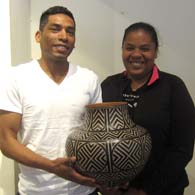 Half Cochiti Pueblo (on her mother’s side), Lisa Holt was born into a well-known multi-generational family of potters in 1980. Her grandmother is Seferina Ortiz, her mother Inez Ortiz and her uncle Virgil Ortiz.
Half Cochiti Pueblo (on her mother’s side), Lisa Holt was born into a well-known multi-generational family of potters in 1980. Her grandmother is Seferina Ortiz, her mother Inez Ortiz and her uncle Virgil Ortiz.Lisa has been making pottery since 1999 and specializes in creating human and animal forms, following long Cochiti tradition. These days she's been making large beautiful ollas and other-worldly dragons and other creatures. She makes all her pieces the traditional way: by hand-coiling the forms from materials she collects and processes herself.
Born in 1978, Harlan Reano is from Santo Domingo Pueblo. He uses Lisa's elegant forms and figures as a three-dimensional "canvas" for his boldly painted designs that range from traditional Kewa geometrics to stylized graffiti patterns. Together, they complete the process by ground firing their innovative and dynamic creations.
Since their debut in 2001, Lisa and Harlan have pushed the shape and design envelope of contemporary Pueblo pottery with their work. Harlan began to revive historic Santo Domingo designs in 2003 and by 2004 he was creating more elaborate "twisted" shapes and figures of his own design. By 2008, they were considered "rising stars" among Native American potters and were beginning to earn some major awards.
They have continued earning awards and accolades for their pottery every year since, in addition to being featured in new books and magazines on contemporary Pueblo pottery almost every year. Their innovations in design and form have captivated many traders and collectors and continue to inspire other artists.
Examples of Lisa and Harlan's work are on display in museums around the world (National Museum of the American Indian, Museum of Indian Arts and Culture, Peabody Essex Museum) and continues to expand the national and international audience for Pueblo pottery.
A while ago we asked Harlan for a count of the ribbons they've earned and his response: "I don't know, quite a few, and we get more every year."
Some Exhibits that featured work by Lisa and Harlan
- Synergy: a Collaboration in Glass. Blue Rain Gallery. Santa Fe, New Mexico. August 16, 2019- August 31, 2019. Note: collaboration between Preston Singletary and Harlan Reano
- Preston Singletary: Artist, Innovator, Collaborator. Blue Rain Gallery. Santa Fe, New Mexico. Opened August 6, 2019. Note: includes collaborative works by Preston Singletary with Harlan Reano, Jody Naranjo, and Tammy Garcia
- Super Heroes: Art! Action! Adventure! Heard Museum. Phoenix, Arizona. May 16 - August 23, 2016
Some Awards earned by Lisa and Harlan
- 2023 Santa Fe Indian Market, Classification IIB, Category 603 - Painted polychrome pottery in the style of Cochiti, Santo Domingo, Santa Clara, San Ildefonso, Tesuque, Nambe, San Juan, Pojoaque, Any form, First Place
- 2023 Smithsonian Craft Fair, Washington, DC, Best in Show
- 2019 Heard Museum Guild Indian Fair & Market, Classification II - Pottery, Division D - Figurative, Native Clay, Hand Built: First Place. Awarded for collaborative artwork: "Unicorn"
- 2018 Heard Museum Guild Indian Fair & Market, Classification II - Pottery, Division D - Figurative, Native Clay, Hand Built: First Place. Awarded for collaborative artwork: "Jackalope Figure"
- 2018 Heard Museum Guild Indian Fair & Market: Judge's Award - Raymond Yazzie. Awarded for collaborative artwork: "Jackalope Figure"
- 2017 Santa Fe Indian Market: Classification II - Pottery, Division B - Traditional, Category 603 - Painted polychrome pottery in the style of Cochiti, Santo Domingo, Santa Clara, San Ildefonso, Tesuque, Nambe, San Juan, Pojoaque, any form: Honorable Mention
- 2017 Santa Fe Indian Market: Classification II - Pottery, Division B - Traditional, Category 605 - Figures/Manas: First Place
- 2017 Heard Museum Guild Indian Fair & Market, Classification II Pottery, Division D - Figurative, Native Clay, Hand Built: First Place. Awarded for collaborative artwork: "Dragon Figure"
- 2011 Heard Museum Guild Indian Fair & Market. Heard Museum. Phoenix, AZ. Class. II - Pottery, Best of Class; - Div. A - Traditional, native clay, hand built, painted, First Place; - 2 Judge's Choice Awards
- 2010 Heard Museum Guild Indian Fair & Market. Heard Museum. Phoenix, AZ. Class. II - Pottery, Best of Class; - Div. A - Traditional, native clay, hand built, painted, First Place; - Div. D - Traditional, native clay, hand built, figurative, Second Place
- 2007 Heard Museum Guild Indian Fair & Market, Classification II - Pottery, Division A - Traditional, native clay, hand built, painted: Honorable Mention
- 2006 Heard Museum Guild Indian Fair & Market, Classification II - Pottery, Division D - Traditional - Native clay/hand built/figurative effigies, canteens, plates, storytellers, nativity scenes: First Place
- 2004 Santa Fe Indian Market. Special Award, Indian Arts Fund Award for Excellence in Traditional Arts; Class. II - Pottery, Div. E - Traditional Pottery, jars, including wedding jars, Cat. 1204 - Jars, Santo Domingo or Cochiti, Second Place; - Div. G - Non-traditional pottery, using traditional materials and techniques, any form or design, Cat. 1405 - Figures, all one piece, can include storyteller bowls, First Place
A Short History of Cochiti Pueblo
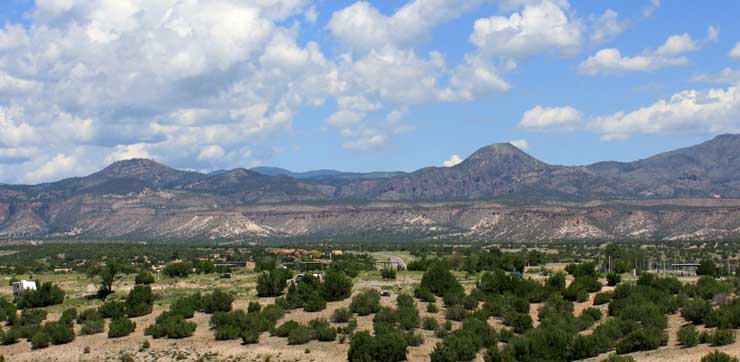
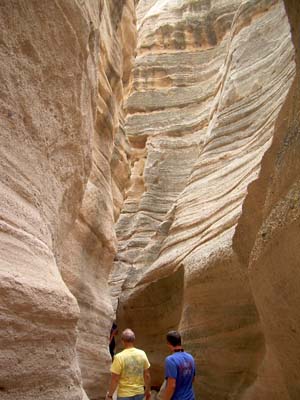
Cochiti Pueblo lies fifteen miles south of Santa Fe along the west bank of the Rio Grande. What is now Bandelier National Monument is the pueblo's most recent ancestral home. They may have relocated to the Bandelier area from the Four Corners region around 1300, and then closer to the Rio Grande in the 1400s in the heart of an even worse drought situation. They merged with people who had been living in the area for hundreds of years before, pushing south until they came up against the countryside of the Tiwa pueblos in the middle Rio Grande.
In those days, the people of Cochiti, Santo Domingo and San Felipe were one Keres-speaking culture. They split into three cultures when some decided to go further down the Rio Grande to settle (San Felipe), and some decided to cross to the eastern side (Santo Domingo). All three speak dialects of Eastern Keres and are considered very conservative.
Cochiti legend says that Clay Old Woman and Clay Old Man came to visit the Cochitis. While all the people watched, Clay Old Woman shaped a pot. Clay Old Man danced too close and kicked the pot. He rolled the clay from the broken pot into a ball, gave a piece to all the women in the village and told them never to forget to make pottery.
Most outsiders who visit Cochiti Pueblo these days do so on the way to or from either the recreation area on Cochiti Lake or Kasha-Katuwe Tent Rocks National Monument.
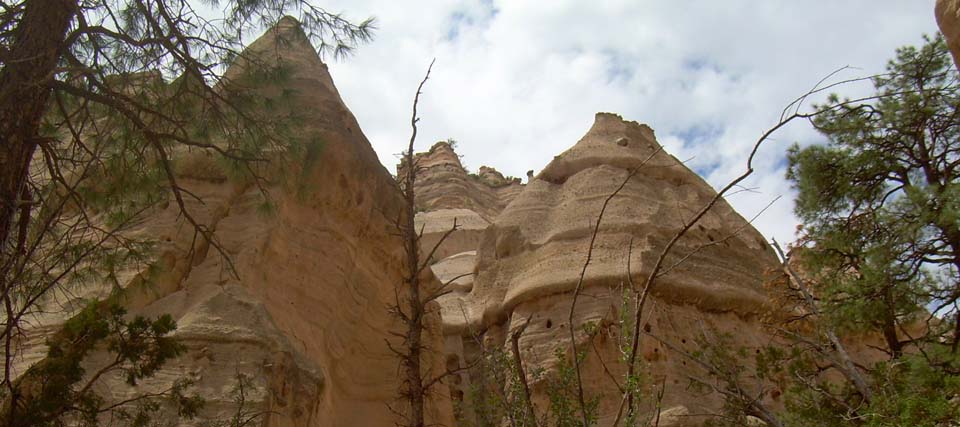
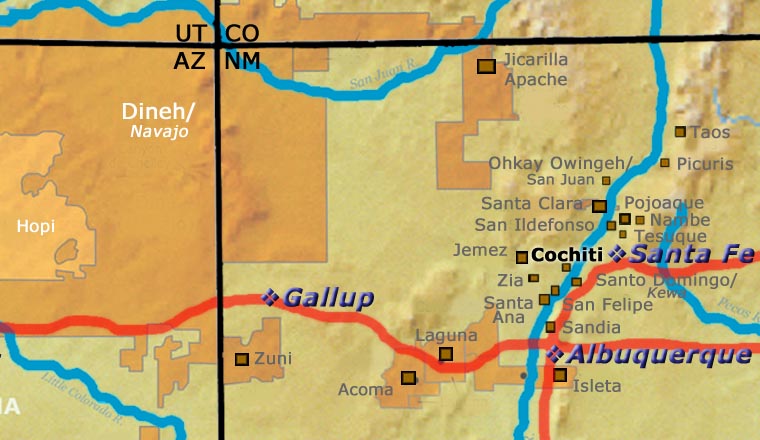
For more info:
Cochiti Pueblo at Wikipedia
Pueblo of Cochiti official website
About Jars
The jar is a basic utilitarian shape, a container generally for cooking food, storing grain or for carrying and storing water. The jar's outer surface is a canvas where potters have been expressing their religious visions and stories for centuries.
In Sinagua pueblos (in northern Arizona), the people made very large jars and buried them up to their openings in the floors of the hidden-most rooms in their pueblo. They kept those jars filled with water but also kept smaller jars of meat and other perishables inside those jars in the water. It's a form of refrigeration still in use among indigenous people around the world.
Where bowls tend to be low, wide and with large openings, jars tend to be more globular: taller, less wide and with smaller openings.
For a potter looking at decorating her piece, bowls are often decorated inside and out while most jars are decorated only on the outside. Jars have a natural continuity to their design surface where bowls have a natural break at the rim, effectively yielding two design surfaces on which separate or complimentary stories can be told.
Before the mid-1800s, storage jars tended to be quite large. Cooking jars and water jars varied in size depending on how many people they were designed to serve. Then came American traders with enameled metal cookware, ceramic dishes and metal eating utensils...Some pueblos embraced those traders immediately while others took several generations to let them and their innovations in. Either way, opening those doors led to the virtual collapse of utilitarian pottery-making in most pueblos by the early 1900s.
In the 1920s there was a marked shift away from the machinations of individual traders and more toward marketing Native American pottery as an artform. Maria Martinez was becoming known through her exhibitions at various major industrial fairs around the country and Nampeyo of Hano was demonstrating her art for the Fred Harvey Company at the Grand Canyon. The first few years of the Santa Fe Indian Market helped to solidify that movement and propel it forward. It took another couple generations of artists to open other venues for their art across the country and turn Native American art into the phenomenon it has become.
Today's jars are artwork, not at all for utilitarian purposes, and their shapes, sizes and decorations have evolved to reflect that shift.
About Geometric Designs
"Geometric design" is a catch-all term. Yes, we use it to denote some kind of geometric design but that can include everything from symbols, icons and designs from ancient rock art to lace and calico patterns imported by early European pioneers to geometric patterns from digital computer art. In some pueblos, the symbols and patterns denoting mountains, forest, wildlife, birds and other elements sometimes look more like computer art that has little-to-no resemblance to what we have been told they symbolize. Some are built-up layers of patterns, too, each with its own meaning.
"Checkerboard" is a geometric design but a simple black-and-white checkerboard can be interpreted as clouds or stars in the sky, a stormy night, falling rain or snow, corn in the field, kernels of corn on the cob and a host of other things. It all depends on the context it is used in, and it can have several meanings in that context at the same time. Depending on how the colored squares are filled in, various basket weave patterns can easily be made, too.
"Cuadrillos" is a term from Mata Ortiz. It denotes a checkerboard-like design using tiny squares filled in with paints to construct larger patterns.
"Kiva step" is a stepped geometric design pattern denoting a path into the spiritual dimension of the kiva. "Spiral mesa" is a similar pattern, although easily interpreted with other meanings, too. The Dineh have a similar "cloud terrace" pattern.
That said, "geometric designs" proliferated on Puebloan pottery after the Spanish, Mexican and American settlers arrived with their European-made (or influenced) fabrics and ceramics. The newcomers' dinner dishes and printed fabrics contributed much material to the pueblo potters design palette, so much and for so long that many of those imported designs and patterns are considered "traditional" now.
Laurencita Herrera Family Tree - Cochiti Pueblo
Disclaimer: This "family tree" is a best effort on our part to determine who the potters are in this family and arrange them in a generational order. The general information available is questionable so we have tried to show each of these diagrams to living members of each family to get their input and approval, too. This diagram is subject to change should we get better info.
-
Laurencita Herrera (1912-1984) & Nestor Herrera
- Mary Frances Herrera (1935-1991)
- Dorothy Herrera (1969-)
- Edwin Herrera (1966-) & Mary Herrera
- Mary Ramona Herrera (1970-)
- Seferina Ortiz (1931-2007) & Guadalupe Ortiz
- Joyce Ortiz Lewis (1954-)
- Leslie Lewis
- Mary Janice Ortiz (1956-)
- Kimberly Walker (1978-)
- Juanita Inez Ortiz (1960-2008)
- Krystal Ortiz (1987-)
- Lisa Holt (1980-) & Harlan Reano (1978-)(Santo Domingo)
- Virgil Ortiz (1969-)
- Leon Ortiz & Jackie Ortiz
- Amanda Ortiz (1988-)
- Joyce Ortiz Lewis (1954-)


